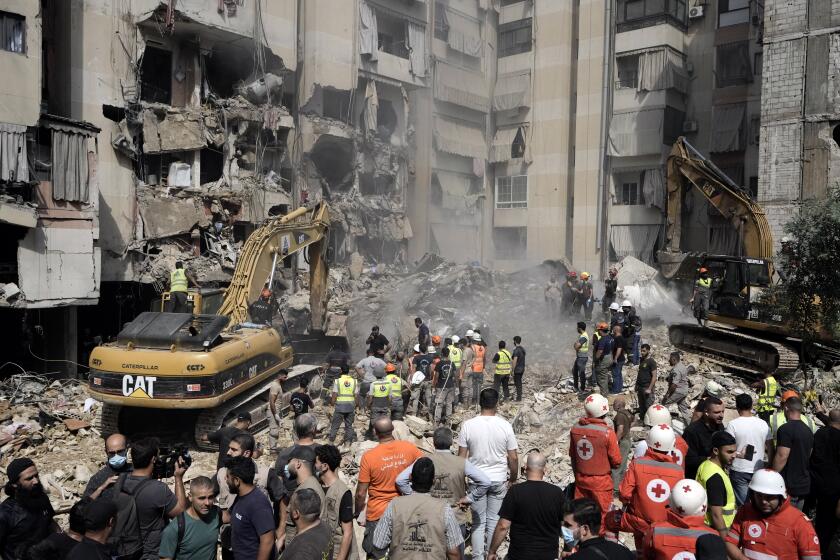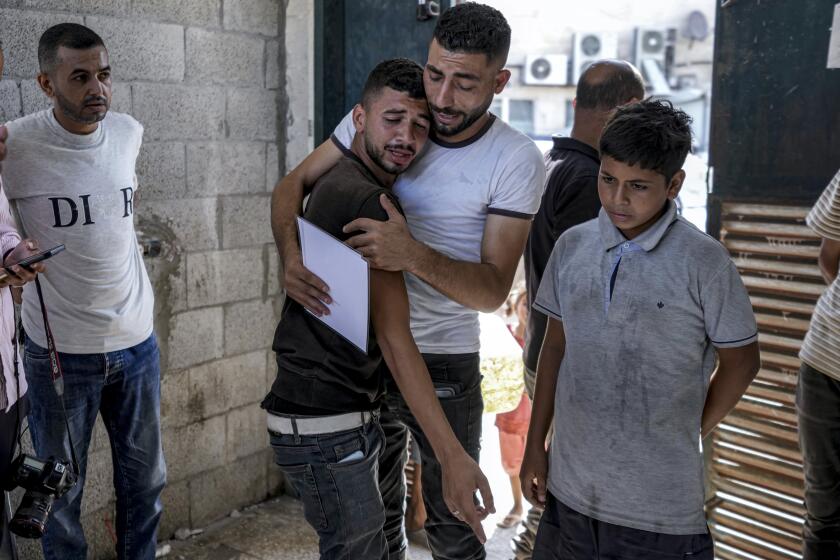CIA Spurned Prison Rules, Report Says
CIA operatives hid inmates, flouted rules and played a corrosive role at Abu Ghraib, the Iraqi facility where prisoners were brutalized and humiliated, according to a military report released Wednesday.
The report does not implicate the intelligence agency in the sexually demeaning treatment of prisoners, which triggered an international scandal when photos of the abuse surfaced in April.
The bulk of the report focuses on the role of military intelligence soldiers and officers in the abuse.
But CIA agents often behaved as if they were above the rules and beyond reproach, ignoring bans on bringing weapons into interrogation booths and bypassing basic requirements on registering prisoners they had taken to the facility, the investigators found.
Agents insisted that at least eight of their prisoners be kept off the books and out of reach of Red Cross inspectors, becoming so-called ghost detainees.
The report disclosed new details about a case in which CIA operatives had interrogated a captive who was later found dead in a shower stall.
In a previously undisclosed case, agency employees locked up three Saudis who were working with the U.S.-led coalition as part of a medical team.
The men weren’t released, military investigators said, until after the help of Secretary of State Colin L. Powell was enlisted, apparently by the Saudi government.
In another instance, a CIA officer brought a weapon into the interrogation booth with him to intimidate a detainee he was questioning.
The officer “drew his weapon, chambered a round and placed the weapon in his holster,” violating strict rules against bringing firearms into the facility, the report said.
Overall, “CIA detention and interrogation practices led to a loss of accountability, abuse, reduced interagency cooperation and an unhealthy mystique that further poisoned the atmosphere at Abu Ghraib,” the report said.
A CIA spokesman declined to comment, but a U.S. intelligence official rejected the findings.
“The report makes broad allegations about the CIA that are not supported by either the text of the report or the material contained in the annexes,” the official said.
But the Army investigation -- led by Maj. Gen. George R. Fay and Lt. Gen. Anthony R. Jones -- uncovered new information that suggested a broader pattern of abuse by the CIA, often referred to in the report as an “other government agency,” or OGA.
At a news conference Wednesday, Fay indicated that investigators had been blocked from pursuing allegations against CIA employees.
He said he had “some specific conversations with the CIA about the issues that we wanted to explore ... and they made it very clear to me that they’re going to conduct their own, thorough, detailed investigation.”
A CIA spokesman declined to say whether the agency had cooperated.
The CIA inspector general’s office in May launched a broad investigation into agency involvement in detention and interrogation abuses in Iraq.
The agency has also referred at least three cases to the Justice Department involving detainees who died in CIA custody, apparently including one at Abu Ghraib.
In some sections of the Army report, investigators scolded the more seasoned CIA operatives for setting a bad example for typically younger military troops engaged in intelligence work. But even senior officers were susceptible to the agency aura, the report said.
Lt. Col. Steven L. Jordan, head of the joint interrogation facility at Abu Ghraib, “became fascinated” with the CIA operatives who frequented the prison outside Baghdad. The agency officers took advantage, the report said, convincing Jordan and his superiors “that they should be allowed to operate outside the established local rules and procedures.”
This led to the much-criticized practice of the CIA delivering so-called ghost detainees, who were incarcerated at Abu Ghraib but never formally entered on the prison rolls.
The report, which called for further investigation, said the practice “caused confusion and acrimony between the Army and OGA, and in at least one instance, acrimony between the U.S. and Saudi Arabian entities.”
In that case, the CIA delivered three “Saudi national medical personnel working for the coalition in Iraq” and asked that they be kept at Abu Ghraib under false names, the report said. The Saudi general in charge of the men asked U.S. authorities to check records for them, but searches using the men’s names repeatedly came back negative.
Ambassador L. Paul Bremer III, then the senior U.S. representative in Iraq, subsequently requested a search, as did the U.S. Embassy in Riyadh, the Saudi capital.
“Ultimately, the secretary of State, Colin Powell, requested a search, and, as with the other requestors, had to be told that the three men were not known to be in U.S. custody,” the report said.
Only after a military official at the compound recalled that the CIA had recently brought in three Saudi men did prison administrators check with the detainees and learn their real identities.
“The men were eventually released,” according to the report, which did not elaborate on why they had been detained.
The CIA spokesman declined to comment on the matter.
The Army investigation also provides fresh details on previously reported alleged CIA abuses, including the death of a prisoner being interrogated by an agency officer in November.
The man, identified in the report only as “Detainee 28,” was suspected of having been involved in an attack against the Red Cross and had been captured by a Navy SEAL team working with agency operatives.
The prisoner “reportedly resisted arrest, so a SEAL team member butt-stroked Detainee 28 on the side of the head to subdue him.”
A CIA official brought the prisoner to Abu Ghraib early in the morning of Nov. 4 and placed him in a shower room used for interrogations.
Hours later, he was found dead in the stall, “facedown, handcuffed with his hands behind his back,” the report said.
The prisoner was kept on ice and taken out the next day on a gurney “as if he were only ill, so as not to draw the attention of the Iraqi guards and detainees.”
The prisoner was later determined to have died of a blood clot in the brain, probably from the injuries he sustained when he was captured.
“Had the CIA followed established Army procedures” when bringing the detainee into the prison, he “would have been medically screened,” the report said, leaving unstated the possibility that his injuries might have been diagnosed and he might have survived.
That death is among those currently under investigation by the CIA inspector general’s office, according to the U.S. intelligence official, and is also reportedly among the three cases referred to the Justice Department.
In another case, a former Iraqi general, Abed Hamed Mowhoush, died in western Iraq in November, several days after being interrogated by agency operatives.
The third incident involved a detainee who died in Afghanistan last year in CIA custody. A CIA paramilitary contractor, David A. Passaro, has been charged in the case, accused of using a large flashlight to beat the prisoner, who was suspected of taking part in rocket attacks on U.S. forces.
More to Read
Sign up for Essential California
The most important California stories and recommendations in your inbox every morning.
You may occasionally receive promotional content from the Los Angeles Times.










